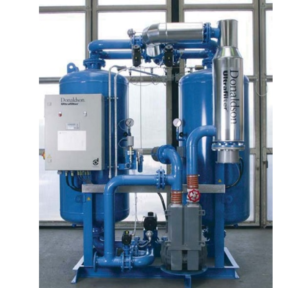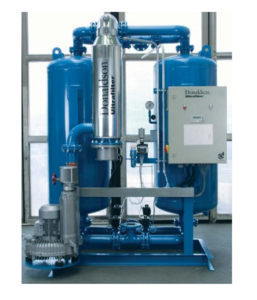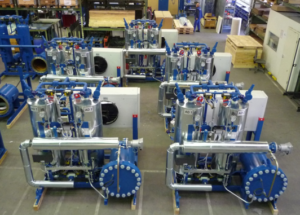In nearly all areas of the industry compressed air is one of the indispensable working medias. The application as working, conveying, measuring, control
and regulating air is just as self-evident as the application in the process technology. The atmospheric inlet air of the compressor contains harmful substances and impurities. Moisture in the form of vapour is condensed out into the compressed air network. This causes expensive damages and a
loss in quality.
Regeneration of the dampened bed is carried out in two steps, depending on the type:
Type HRS
The desorption and cooling in the HRS system variation is also accomplished with the ambient air drawn in by the blower. Compressed air will not be used during the desorption or the cooling phase.
Since the desorption occurs in counter current flow,
a low energy consumption is required. The HRS is
therefore the most energy efficient option
Type HRE
As with all externally heated adsorption dryers the desorption of the moisture adsorbed in the desiccant of the HRE models takes place with the heated blower air stream. The cooling of the desiccant is conducted with partial flow of the already dried compressed air. Because the cooling process is independent of the ambient conditions the HRE models can be used worldwide
It is possible to develop an individual project for a given application.


More on :
Osuszacz typ HRE, HRG, HRS broszura (EN)
Osuszacz typ HRE – do 2% strat, regeneracja ciepłem kompresji (EN)
Adsorption dryer where regeneration takes place using an external heat source. Dehydration occurs in the opposite direction to adsorption when using externally heated gas in a closed circuit (no consumption of compressed gas). In contrast, the cooling occurs in the opposite direction to adsorption using dried compressed gas in a closed circuit.

Automatically regenerated natural gas dryers for gas distribution stations for wheeled vehicles do not generate losses during drying.
Currently implemented types:
- Type 1: ARNG – 1000 S for 1000 Nm³ / h
- Type 2: ARNG – 2000 S for 2,000 Nm³ / h
Construction
- tanks and piping made of carbon steel, designed and approved in accordance with CE requirements
- has filters; initial and final
- has pneumatically operated double-sided armatures
- has an electric heater and an air-cooled regenerative cooler
- heater, tank and piping joints insulated with mineral wool and covered with galvanized sheet metal
- wiring on the terminal housing (SPS controller if required)
- all components are completely assembled on a steel frame
- all carbon steel parts are sandblasted, coated and painted in RAL 5019 in accordance with Donaldson standards
- adapted for outdoor installations under roof at positive temperatures
Verification
- Final assembly
(After painting mounting all unpainted parts, such as air control tubes, manometers, transmitters, wiring, …)
- Air / nitrogen tightness test at 20 bar
0-10 bar compressed air (compressor), 10-20 bar nitrogen (gas cylinders)
(Working pressure: 18.6 bar; design pressure of the tank 22 bar)
- Functional test
(After final assembly – control of the heater, blowers, actuators, valve terminal, …)